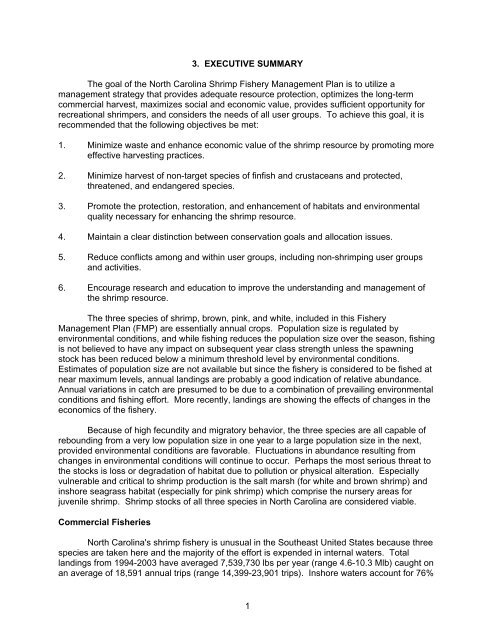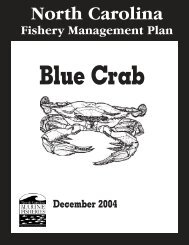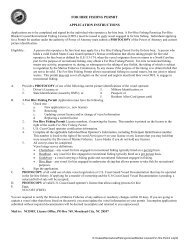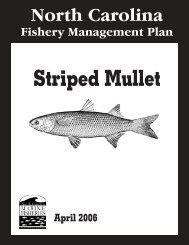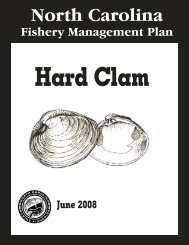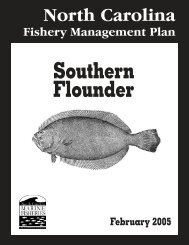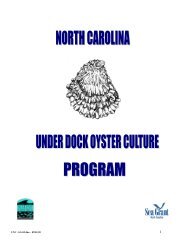- Page 4 and 5: 2. TABLE OF CONTENTS1. ACKNOWLEDGME
- Page 8 and 9: and ocean waters 24% of the total h
- Page 10 and 11: 4. INTRODUCTION4.1 LEGAL AUTHORITY
- Page 12 and 13: ycatch reduction devices, area clos
- Page 14 and 15: 4.5 EXISTING PLANS STATUTES, AND RU
- Page 16 and 17: RCGL trawling, 50 crabs, not to exc
- Page 18 and 19: coastal and inland fishing waters.
- Page 20 and 21: Pink shrimp:Pink shrimp are found f
- Page 22 and 23: Brown shrimp marked by McCoy (1968)
- Page 24 and 25: Pamlico County fishermen began land
- Page 26 and 27: 6.1.3 State Landings and EffortLand
- Page 28 and 29: Table 6.2.Percent contribution of l
- Page 30 and 31: account for the remaining landings.
- Page 32 and 33: from the fall fishery, where it is
- Page 34 and 35: NorthernPamlicoCentralSouthernFigur
- Page 36 and 37: Figure 6.8. Acreages of North Carol
- Page 38 and 39: $30,000,000$25,000,000Inflated Valu
- Page 40 and 41: Table 7.1.Detail values of pounds l
- Page 42 and 43: from 1994 through 2003, 50% of all
- Page 44 and 45: Table 7.3 (cont.) Pounds and value
- Page 46 and 47: Table 7.4.Number of participants in
- Page 48 and 49: Number of Dealers310290270250230210
- Page 50 and 51: These two numbers estimate that ove
- Page 52 and 53: as opposed to those who made day tr
- Page 54 and 55: Table 8.1. Most frequently cited co
- Page 56 and 57:
Figure 8.1. Frequency of conflict e
- Page 58 and 59:
Figure 8.3. Frequency of negative e
- Page 60 and 61:
Table 8.3.Fishing related issues co
- Page 62 and 63:
Table 8.4. Demographic characterist
- Page 64 and 65:
8.5 Definitions and AcronymsCommerc
- Page 66 and 67:
Table 9.1.Spawning seasons for Pena
- Page 68 and 69:
Figure 9.1a.Distribution of riparia
- Page 70 and 71:
Figure 9.1c.Distribution of riparia
- Page 72 and 73:
uppermost portion of shallow creek
- Page 74 and 75:
Figure 9.2b.Shrimp nursery areas, i
- Page 76 and 77:
an area closed to mechanical harves
- Page 78 and 79:
of nutrients from non-point sources
- Page 80 and 81:
designated areas. Much of the desig
- Page 82 and 83:
Figure 9.3b. Areas where mechanical
- Page 84 and 85:
Shell bottomShell bottom habitat is
- Page 86 and 87:
asins are excessive sediment loadin
- Page 88 and 89:
polychaetes and large clams might b
- Page 90 and 91:
shrimp. The effect of bacteria on m
- Page 92 and 93:
Habitat Areas” (SHAs). Strategic
- Page 94 and 95:
funding (state and federal) may be
- Page 96 and 97:
Action 5:Current Phase II stormwate
- Page 98 and 99:
Committee. Bycatch characterization
- Page 100 and 101:
10.1.7.3 Recommended Management Str
- Page 102 and 103:
10.1.10 GEAR SIZE RESTRICTIONS10.1.
- Page 104 and 105:
frequently shrimped by Recreational
- Page 106 and 107:
is limited to a few patches in the
- Page 108 and 109:
small white shrimp recruit to the a
- Page 110 and 111:
when they reach a marketable size,
- Page 112 and 113:
who benefit are a few channel net f
- Page 114 and 115:
a) Implement headrope size limit on
- Page 116 and 117:
2. Harvest Season (Month (s), or Mo
- Page 118 and 119:
10.1.26.2 Management Options1. Stat
- Page 120 and 121:
mid July (based on predetermined he
- Page 122 and 123:
10.2.5 Biological Research Needs (n
- Page 124 and 125:
Coen, L. E., M.W. Luckenbach, and D
- Page 126 and 127:
Gilmore, G. and Trent X. 1974. Abun
- Page 128 and 129:
Maiolo, J.R. 2004. Hard Times and a
- Page 130 and 131:
Paerl, H. W., J. Pinckney, J. Fear,
- Page 132 and 133:
Teal, J. 1962. Energy flow in salt
- Page 134 and 135:
12. APPENDICES12.1 Appendix 1 SUMMA
- Page 136 and 137:
ADMINISTRATIVEORGANIZATIONLICENSESR
- Page 138 and 139:
12.2 Appendix 2 MANAGEMENT OF TRAWL
- Page 140 and 141:
substrates, and destabilizing the r
- Page 142 and 143:
In North Carolina, Corbett et al. (
- Page 144 and 145:
depth, tides, bottom types, sea gra
- Page 146 and 147:
V. MANAGEMENT OPTIONS/IMPACTS1. Sta
- Page 148 and 149:
VIII.LITERATURE CITEDASMFC (Atlanti
- Page 150 and 151:
12.3 Appendix 3 SHRIMP TRAWL BYCATC
- Page 152 and 153:
accounting for 80% of all finfish l
- Page 154 and 155:
made up 94% of the finfish bycatch
- Page 156 and 157:
thought that such species-specific
- Page 158 and 159:
North Carolina are considered healt
- Page 160 and 161:
gain was demonstrated from raising
- Page 162 and 163:
threshold estimates. Also, biomass
- Page 164 and 165:
only recently has the affect of byc
- Page 166 and 167:
the 8" webbing. This hoop is 30" in
- Page 168 and 169:
the case in South Carolina, most of
- Page 170 and 171:
‚ From December 1 through March 3
- Page 172 and 173:
VII.Literature Cited:Alverson, D.L.
- Page 174 and 175:
Pearce, K.B., D.W. Moye, and S.K. S
- Page 176 and 177:
Table 2.Percent Shrimp trawl landin
- Page 178 and 179:
Table 5. Yearly finfish landings (l
- Page 180 and 181:
Table 6.Total shrimp trawl landings
- Page 182 and 183:
Table 8. ContinuedYear %Species 199
- Page 184 and 185:
Table 10.Total monthly value of fin
- Page 186 and 187:
Table 13.Monthly shrimp trawl crab
- Page 188 and 189:
Table 16.Total monthly value of cra
- Page 190 and 191:
Table 19.Monthly shrimp trawl Mollu
- Page 192 and 193:
Table 22. Total monthly value of Mo
- Page 194 and 195:
Table 26. ContinuedArea Rank Specie
- Page 196 and 197:
Table 27. ContinuedArea Rank Specie
- Page 198 and 199:
Table 29.Finfish catch composition
- Page 200 and 201:
Table 32.Results of 1 ½” diamond
- Page 202 and 203:
Table 34.Results of experimental to
- Page 204 and 205:
Table 36.Results of experimental to
- Page 206 and 207:
Table 38. Results of experimental t
- Page 208 and 209:
Table 40.Results of experimental to
- Page 210 and 211:
Top viewTop viewof trawlcenterline1
- Page 212 and 213:
Figure 3.Diagram of modified large
- Page 214 and 215:
12.4 Appendix 4. SOUTHERN FLOUNDER
- Page 216 and 217:
CAA NUMBERS2,000,0001,800,0001,600,
- Page 218 and 219:
confirms this analysis. A theoretic
- Page 220 and 221:
12.5 Appendix 5. SHRIMP MANAGEMENT
- Page 222 and 223:
occurs.Closing an area in mid-seaso
- Page 224 and 225:
12.6 Appendix 6. SHRIMP POUND NET S
- Page 226 and 227:
lead and pound or heart in use.V. M
- Page 228 and 229:
700000600000500000400000Figure 1.Po
- Page 230 and 231:
minimum distance requirements is th
- Page 232 and 233:
12.8 Appendix 8. THE RECREATIONAL S
- Page 234 and 235:
Individuals01 to 1011 to 100101 to
- Page 236 and 237:
NorthernPamlicoCentralSouthernFigur
- Page 238 and 239:
Central8%Southern3%Northern33%Pamli
- Page 240 and 241:
6) Seasonal / Daily - Weekly Restri
- Page 242 and 243:
subject on several occasions as it
- Page 244 and 245:
western part of the sound. These ar
- Page 246 and 247:
Typically, the annual shrimp manage
- Page 248 and 249:
a given year made only one or two t
- Page 250 and 251:
New River - 2003New River - 2004Inv
- Page 252 and 253:
Number of Trips by Participants in
- Page 254 and 255:
RecommendationsAC Recommendation: S
- Page 256 and 257:
Biomass Percent (lbs) Chadwick Bay
- Page 258 and 259:
252
- Page 260 and 261:
12.12 Appendix 12. SHRIMP MANAGEMEN
- Page 262 and 263:
Pamlico SoundCore SoundNew RiverNew
- Page 264 and 265:
Table 1.Catch and effort data on sh
- Page 266 and 267:
Biomass Percent (lbs), Stump/Topsai
- Page 268 and 269:
12.13 Appendix 13. SHRIMP MANAGEMEN
- Page 270 and 271:
Pamlico SoundCore SoundNew RiverNew
- Page 272 and 273:
The size (counts) of shrimp landed
- Page 274 and 275:
12.14 Appendix 14. SHRIMP MANAGEMEN
- Page 276 and 277:
Table 1.Trip ticket data from the o
- Page 278 and 279:
Preliminary bycatch results from a
- Page 280 and 281:
8Frequency642041-5051-6061-7071-808
- Page 282 and 283:
Pamlico SoundCore SoundNew RiverNew
- Page 284 and 285:
each year (Figure 6). The majority
- Page 286 and 287:
Map 1.IWW from Cape Fear River to H
- Page 288 and 289:
Table 1. Catch and Effort data on s
- Page 290 and 291:
high tides when beds were more acce
- Page 292 and 293:
12.17 Appendix 17. SHRIMP MANAGEMEN
- Page 294 and 295:
Management Option/Impacts+ potentia
- Page 296 and 297:
- Eliminates potentially lucrative
- Page 298 and 299:
12.19 Appendix 19. SHRIMP MANAGEMEN
- Page 300 and 301:
12.20 Appendix 20. SHRIMP MANAGEMEN
- Page 302 and 303:
Figure 1.Neuse River open.In review
- Page 304 and 305:
Figure 3.North side of Neuse River
- Page 306 and 307:
Table 3.Finfish catch composition (
- Page 308 and 309:
MFC Recommendation: Restrict total
- Page 310 and 311:
most abundant species accounting fo
- Page 312 and 313:
Table 2. Monthly percent contributi
- Page 314 and 315:
Table 5. Percent contribution of da
- Page 316 and 317:
Pounds%cumulative pounds14,000100.0
- Page 318 and 319:
Map 1. Map of Pamlico and Albemarle
- Page 320 and 321:
Management Option/Impacts+ potentia
- Page 322 and 323:
12.22 Appendix 22. SHRIMP MANAGEMEN
- Page 324 and 325:
Table 1.Landings (lbs) of finfish f
- Page 326 and 327:
Table 3.Monthly shrimp landings (lb
- Page 328 and 329:
Table 5. Percent contribution of da
- Page 330 and 331:
Table 7. Percent contribution of va
- Page 332 and 333:
Map 1. Map of Pamlico and Albemarle
- Page 334 and 335:
Management Option/Impacts+ potentia
- Page 336 and 337:
WadesPointMap 3. Map of Pamlico Riv
- Page 338 and 339:
enefit the stock. Management of Pun
- Page 340 and 341:
Table 4. Percent contribution of da
- Page 342 and 343:
Map 1. Map of Pamlico and Albemarle
- Page 344 and 345:
Upper PungoCPUE = 14Mid PungoCPUE =
- Page 346 and 347:
3. Area Closuresa) Prohibit all shr
- Page 348 and 349:
35000003000000250000020000001500000
- Page 350 and 351:
5,000,0004,500,0007,035,8694,000,00
- Page 352 and 353:
The National Marine Fisheries Servi
- Page 354 and 355:
4) Prohibit all trawling+ Possible
- Page 356 and 357:
and number. Atlantic croaker, spot,
- Page 358 and 359:
Table 2. Monthly percent contributi
- Page 360 and 361:
Table 3.Monthly shrimp landings (lb
- Page 362 and 363:
Map 1. Map of Pamlico and Albemarle
- Page 364 and 365:
Map 3 Shrimp areas closed by procla
- Page 366 and 367:
3. Area Closuresa) Prohibit all shr
- Page 368 and 369:
8,000,000Pamlico Sound Total landin
- Page 370 and 371:
Table 2. Monthly percent contributi
- Page 372 and 373:
RoanokeSoundMap 1. Map of Pamlico a
- Page 374 and 375:
Management Option/Impacts+ potentia
- Page 376 and 377:
12.27 Appendix 27. SHRIMP MANAGEMEN
- Page 378 and 379:
Table 1.Landings (lbs) of finfish f
- Page 380 and 381:
Table 3.Monthly shrimp landings (lb
- Page 382 and 383:
Map 2. Map of Croatan Sound North C
- Page 384 and 385:
3. Area Closuresa) Prohibit all shr
- Page 386 and 387:
(B)(C)(D)Not more than 100 yards of
- Page 388 and 389:
22.8671' N - 75° 33.5851' W in Avo
- Page 390:
Amended Eff. March 1, 1994;Recodifi


